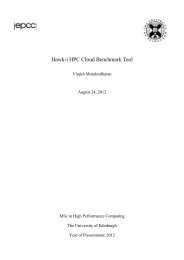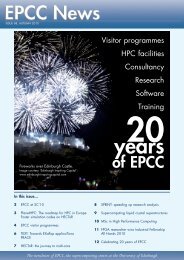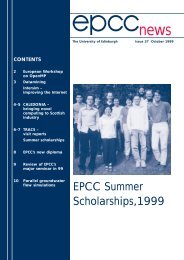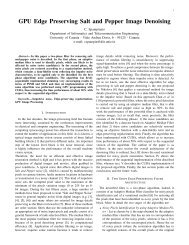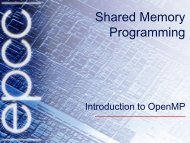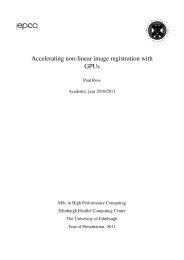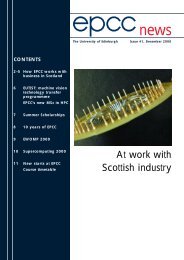Download PDF - EPCC - University of Edinburgh
Download PDF - EPCC - University of Edinburgh
Download PDF - EPCC - University of Edinburgh
Create successful ePaper yourself
Turn your PDF publications into a flip-book with our unique Google optimized e-Paper software.
FOCUS: HARDWARESelf-assembly and hydration inbiological systems:lessons from smallmoleculesJason Crain, School <strong>of</strong> Physics, <strong>University</strong> <strong>of</strong> <strong>Edinburgh</strong>Understanding the principles and processes by which proteinsin aqueous solutions assemble from amino acid chainsinto biologically functional three-dimensional structuresis recognised as one <strong>of</strong> the major challenges spanning thephysical and life sciences. In addition to fundamental interestin the factors surrounding this process, protein mis-foldingevents are also attributed to diseases such as cystic fibrosis,Creutzfeldt-Jakob disorder and Alzheimers. Therefore, thelong-term impact <strong>of</strong> advances in this area also reaches intomedicine and may have future ramifications for protein andpeptide design. The basic molecular-scale issues that underliefolding and other related ‘self-organisation’ phenomena arevery general and concern the following themes:1) Hydration structure: How are the water moleculesorganised around the polar, non-polar and peptide groups <strong>of</strong>complex biomolecules? How is this organization influencedby externally-controllable conditions such as temperature andpressure?2) Molecular flexibility: How flexible are the bonds <strong>of</strong>complex molecules that define overall macromolecular shape?And how is this flexibility affected by hydration structureand other environmental factors such as pressure andtemperature?3) Ionic (H<strong>of</strong>meister) Effects: How does the presence <strong>of</strong>simple inorganic ions influence hydration structure andflexibility?The size, complexity and diversity <strong>of</strong> real proteins andbiomolecules still renders a thorough molecular-levelinvestigation <strong>of</strong> these issues impractical for systems <strong>of</strong> directbiological relevance. A promising emerging strategy in thestudy <strong>of</strong> processes with inherently high levels <strong>of</strong> structuralcomplexity, multiple degrees <strong>of</strong> freedom and competinginteractions makes use <strong>of</strong> so-called model systems whichrepresent extreme approximations <strong>of</strong> ‘real’ macromolecularmaterials. Chosen carefully, and with appropriatecombinations <strong>of</strong> computational and experimental input,co-ordinated investigations on model systems can be veryA simulation <strong>of</strong> complexbiological molecules.powerful, leading to insight into muchmore complex systems. In the specificcase <strong>of</strong> the protein folding problem and self-organisationphenomena in biomolecules, there are potentially many viewsas to what level <strong>of</strong> abstraction relative to a real biomoleculeis ‘useful’ for a particular purpose. Ultimately, there mustbe some compromise found between the degree <strong>of</strong> ‘realism’<strong>of</strong> the system and the level <strong>of</strong> detail at which the system isdescribed. In those cases where the fundamental questionsare general rather than specific to particular biomolecules,extreme simplifications <strong>of</strong> real biological systems may bemade. The benefit <strong>of</strong> this approach is that very sophisticatednew computational (such as polarisable models and pathintegral molecular dynamics) and experimental tools(isotope-labelled neutron diffraction and empirical potentialstructure refinement) can be deployed together for the firsttime to build confidence in new models.With this strategy in mind, a major collaboration betweenthe <strong>University</strong> <strong>of</strong> <strong>Edinburgh</strong> and IBM Research has beenestablished to combine massively parallel supercomputingwith high-resolution neutron diffraction experiments atatomic resolution. To support the project IBM has recentlyannounced a major Shared <strong>University</strong> Research (SUR) awardto <strong>Edinburgh</strong> including leading-edge Power5 microprocessortechnology (16-way SMP, 1.9GHZ p570 processors with128GB RAM) and high performance graphics workstationsenhanced by world-class 9 million pixel LCD monitors forvisualization <strong>of</strong> complex structures. The pSeries system willbe housed at the ACF, where support for the machine will beprovided by <strong>EPCC</strong>. The project also makes extensive use <strong>of</strong>the Blue Gene systems in both the ACF and in the TJ WatsonCenter.9



